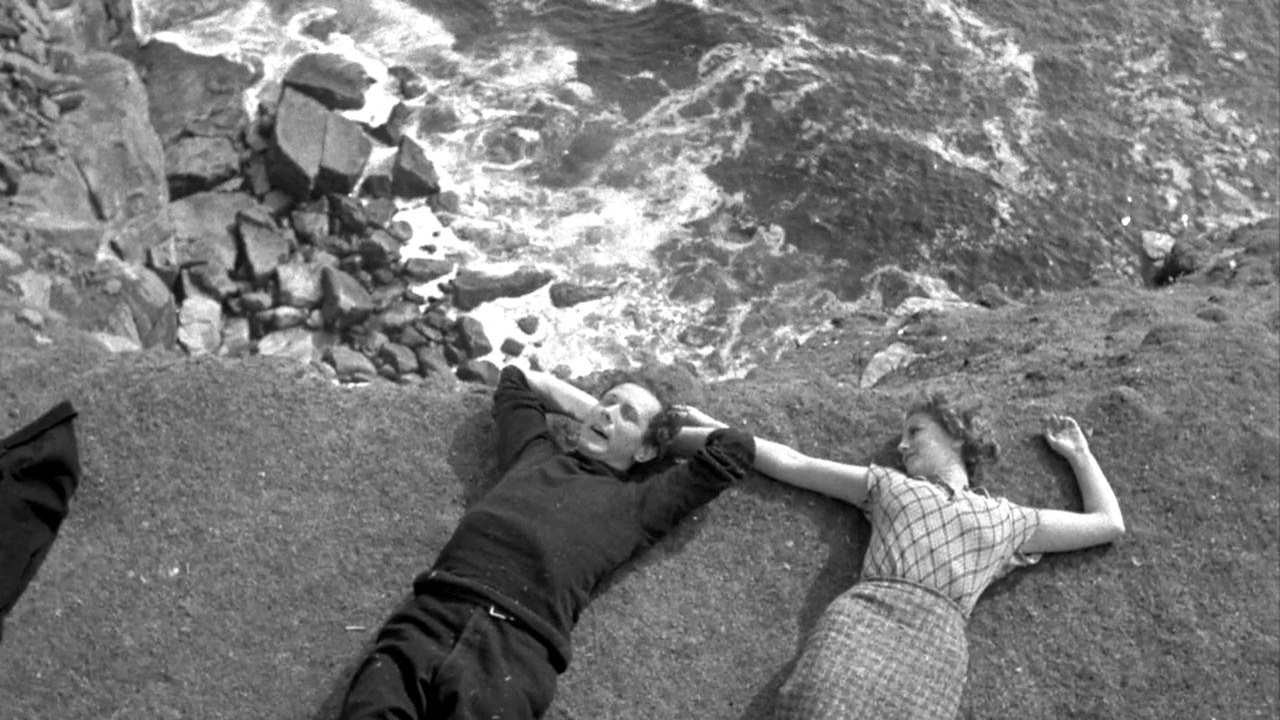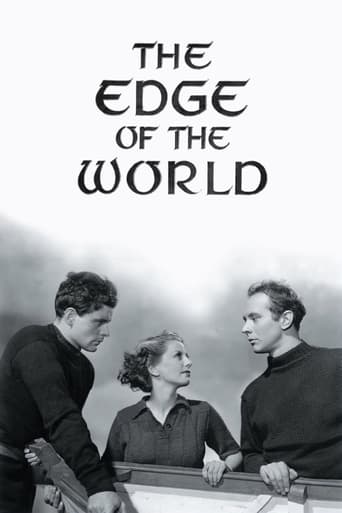

What's it like to live on a treeless rock in the middle of the roiling north Atlantic. We get a pretty good idea from master film-maker Michael Powell who set up his camera in such a place with a few actors, a scant script, and actual residents as extras. And a heck-of-a movie it is. The result looks like something from the neolithic era, with its crude rock huts, long barren vistas, and a few hunkered-down plants, along with jagged cliffs rising out of the sea like the face of God. One thing for sure -- there's no lack of fresh air .I can't imagine the movie was made for commercial potential. It resembles Robert Flaherty's gripping documentary of life in the Irish Sea, Man of Aran, which may be why Powell distinguished his effort with a story-line. But the visuals are quite similar. And that's fine, because the craggy vistas are unforgettable. This is close to movie making at its purest and most visual. In fact, on another viewing, I think I'll turn off the sound and simply gasp at the other-world imagery.The story may be secondary, but it's appropriate. The few remaining islanders are leaving after centuries of habitation because of deteriorating conditions. There's a romantic complication, but thankfully it doesn't get in the way. A few scenes etch themselves in my memory-- the sheep dogs lined-up outside the crude church, the tiny mail-carrying boats tossed into the sea like wishes, but most of all, the overawing sea cliffs, endless in their poetry and power. It's got to be here that the earth meets the sky or whatever it is that's above.Rather hard for me to believe that this spartan black and white was made by the same artist who made the splashy Technicolors of The Red Shoes and Peeping Tom. But Powell excelled at cinema regardless of format, putting him in the same league as the few other British masters like Alfred Hitchcock. But whatever the pedigree, this 80 minutes of air, rock and water remains a really compelling oddity.
... View MoreThis is truly a great classic film which was located on an Island called Foula near Scotland and this film calls it the Shetland Island where a group of Scotish people dwell in the fog and a stormy sea against huge rocks and cliffs. There is naturally a love story between a man and a woman who are unable to get married because the young lady's father will not give his permission for the marriage. You see a very primitive way of living and it is rather depressing to see nothing but gloomy and stormy days all the time on this island that is not able to support itself and will eventually have to be vacated. The film makers had a very hard job in trying to bring their camera equipment up the steep cliffs of this island and the weather conditions also gave a great deal of problems to the production of this film. In many ways this is a very unusual film and the title for this film is very suitable for this film which is almost hard to believe that people could possibly ever live on an island like this.
... View MoreOdd little film directed by Michael Powell long before his huge success once teamed with Emeric Pressburger.Subtitled "the death of an island," the film chronicles the dreary lives of island folk as seen in flashback by the former residents years after. Victims of the changing world, commercialized fishing, and isolation, the islanders finally pack it in and move to the mainland after the death of one young man and a near miss with a baby.Set in an era before electricity and telephones the film shows just how isolated the people are on the various islands north of Scotland. Independent and stubborn, they cling to their rock even though they know the end is coming.The story is slim: the young people are in crisis of whether to stay and keep the island going or go to the mainland and get good-paying jobs. The story shows us their lives on the island of Hirta (which means death) and the draw of the cities.Almost shot in documentary form, Powell constantly shows us the majestic beauty of the sparse rock of island versus the drab lives of the people. Their lives are built around church, social interaction, and trying to keep going.The acting is minimal with a few familiar faces. John Laurie is the hard father who sees his son (Eric Berry) die in a stupid accident while climbing the face of sea rock. Belle Chrystall is Ruth and Niall MacGinnes is Robbie. Finlay Currie co-stars.The island scenery is just gorgeous and Powell has a good eye for the incredible backdrops of sea and rock and waving grasses.
... View MoreLike Michael Powell, I was struck by the pathos when I learned of the story of the abandonment of St Kilda, and the concomitant end of a centuries-old way of life in this harsh but oddly beautiful place. I am facinated by abandoned places, both modern and ancient, as well as by the creativity employed in eking a survivalist living out of extreme, inhospitable, barren environments far from the comforts of civilisation. Therefore I was delighted when I learned of this movie's existence, hoping to get an insight into the islanders' way of life, lingering shots of the village ruins, and a sense of the pathos of the island's end.I didn't quite get what I was hoping for, as some things seemed a little rushed in this short film, while others such as the protracted dancing at the birth took up excesive time. The key aspects of the islanders way of life are only revealed in brief glimpses. We do get a scene in the church, but without the DVD commentary we wouldn't know that the church was the island's central social institution. The occasional famines which destroyed the real St Kilda are only briefly hinted at in the film, with one brief scene talking of how the poor growing conditions will affect the harvest. I didn't fully understand the effect of the fishing boats without the DVD commentary. The laird's feudalistic power isn't really touched on - indeed when the laird makes an appearance, I didn't even know who he was. You don't get enough of a look at the old way of life to appreciate or lament that anything has been lost. Instead you jump straight into the arguments over whether or not to abandon the island, which should have been Act 2. Instead of the plot centring around the struggle to survive on Hirta, the story and the arguments over whether to leave centred around a soppy, melodramatic love story. When the islanders do decide to leave, it's all a bit of an anti-climax, without the escalating dramatic conflict one would expect leading up to the film's central moment. The two tragedies which provide the film with its drama are admittedly tense, but you can predict exactly how they'll end when the episodes have barely begun.Despite these quibbles, I thought the film was amazing, not for its story but for its visual poetry. The cinematography is magnificent, and the shots of the island and its hardy characters take the breath away. While the stilted acting may betray the film's age, there is nothing out of date about the beautifully composed images. Some of the shots from seemingly impossible angles would make Kubrick proud. It's all the more impressive when you consider the trying circumstances in which it was filmed.In short see the film for its spectacular must-see images, and don't worry too much about the plot.
... View More